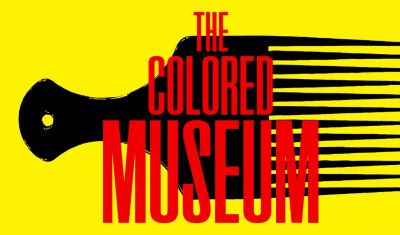A FANTASIZED LOOK INTO BLACKNESS IN AMERICA
The Colored Museum by George C. Wolfe, currently at The Studio Theatre, is a wild, satirical glance into African-American experiences, dating back to slaves in Africa to the present (which was 1986 when Wolfe penned it). The experiences are how Blacks are portrayed to a white public, as well as how Blacks perceive themselves in a mostly white world.
As Miss Pat, a perky flight attendant narrator, played by Ayanna Bria Bakari, tells the audience at the start of the play, what we are to experience will be a “bumpy ride.”
Iris Beaumier and Matthew Elijah Webb
Director Psalmayene 24 relays the production into an immersive experience. To start, audience members sit on scratchy wooden benches that simulate a slave ship. Miss Pat advises us – her passengers – to fasten our shackles. Meanwhile, the extraordinarily talented Jabari Exum, dressed as a security officer on the ship, beats out a harrowing rhythm on his congas.
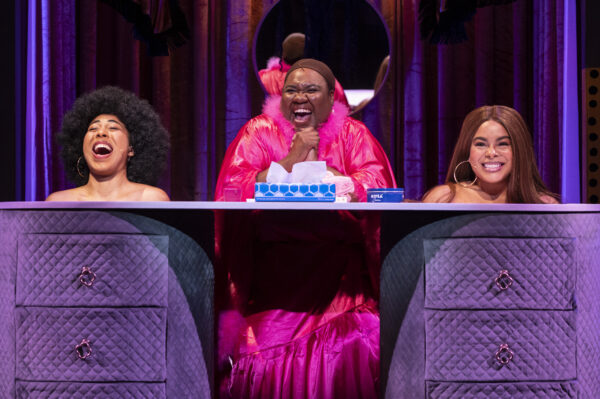 Iris Beaumier, Kelli Blackwell, and Ayanna Bria Bakari
Iris Beaumier, Kelli Blackwell, and Ayanna Bria BakariThe play is structured as a series of 11 exhibits or sketches (in the museum) that explore the Black experience in white America. Five talented actors and actresses – Bakari, Kelli Blackwell, Iris Beaumier, Matthew Elijah Webb, and William Oliver Watkins – portray multiple characters, with the help of Moyenda Kullemeka’s bold and beautiful costumes and wigs. The transformations from one character to another are so seamless it feels like we’re witnessing many more than five people on stage.
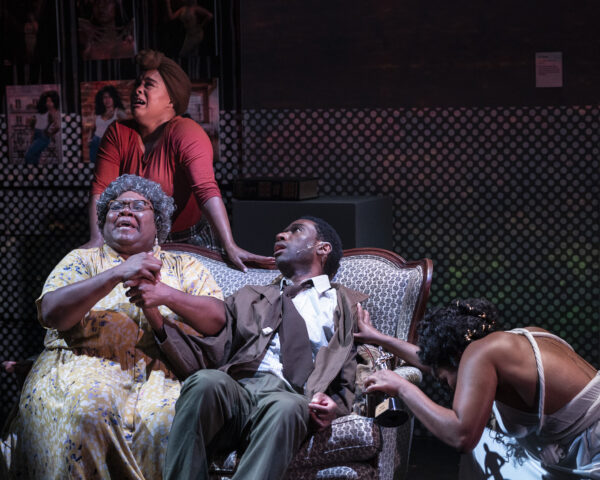 Ayanna Bria Bakari (top), Kelli Blackwell, William Oliver Watkins, and Iris Beaumier (bottom)
Ayanna Bria Bakari (top), Kelli Blackwell, William Oliver Watkins, and Iris Beaumier (bottom)The sketches are at times hysterical, at times depressing. Some of them hit home, while others are more murky. All of them are “over the top” in their daring ridicule, which sometimes works, and at other times go a bit too far in their buffoonery to the point of exhaustion.
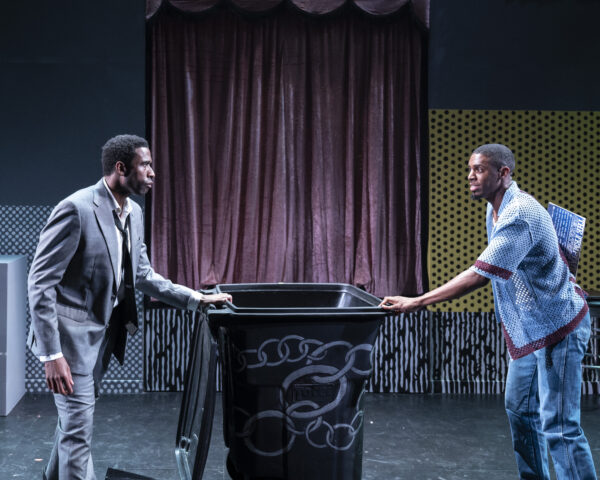 William Oliver Watkins and Matthew Elijah Webb
William Oliver Watkins and Matthew Elijah WebbOne of the most successful sketches is a play mimicking A Raisin in the Sun, which the narrator says “tears at the fabric of racist America.” The play, titled The Last Mama on the Couch, is complete with a “well-worn couch” on which sits a “well worn Mama” and her obligatory portrait of a white Jesus on the wall; her angry son Walter Lee, who curses “The Man;” his wife who enters doing an interpretive dance that morphs into a parody of African dance; and his sister, whose affective speech resembles Shakespearean sonnets, since, of course, she studies at Julliard. All the characters are extreme stereotypes, which results in hilarity. Walter, who cries, “It’s all about me and my pain,” gets shot, and Momma exclaims his destiny would have fared better had he been in an all-Black musical, at which point the family’s gospel singing revives Walter from the dead and they all end up dancing (choreography by Tony Thomas) and singing together. Meanwhile, each actor trades off receiving an award for over-acting.
Although A Raisin in the Sun by Lorraine Hansberry is an iconic and ingenious portrayal of Blackness in the 1950s, playwright Wolfe could be making the statement that it has become overdone and it’s time for new cultural artistry to display Black identify.
Matthew Elijah Webb and William Oliver Watkins
Another scene that worked well is when Webb and Watkins play two-sides of the same person – a professional African-American who is trying to throw away his “Blackness” so he can succeed in a white world – arguing with his younger self’s Black identity who desperately wants to hold onto his cultural and racial history.
“I have no history,” says the professional in a suit. ’˜Being Black is too emotionally taxing ’¦ I’ll only be Black on weekends and holidays!” He states this while throwing away his first Converse sneakers, Afro-Sheen, Michael Jackson records, and more artifacts of Black America, into a large dumpster.
His counter-ego argues with him: “We need each other; we are one” as he makes a desperate plea to at least save The Temptations record with his favorite song, “My Girl.”
The conflict and anger between the two men is fierce and feels very real; the skit is a metaphor for inner conflict in the Black community.
Iris Beaumier and Kelli Blackwell
A sketch that — a little too abstract for complete understanding — was a satire of The Color Purple. It features a young teenager with cornrows in her hair, ballooned out with pregnancy that resulted from sex with the garbage man. A bit of humor is that the garbage man ironically smelled of fruit rather than rubbish; she exclaims it was like having sex with a fruit salad, but she didn’t spit out the seeds. The young girl then gives birth to a gigantic white egg. The girl struggles with self-esteem; she tells the audience her mother told her that when God was bored, he made her. She says that her egg – which she is hatching in a white society – will produce many new lives that she hopes will be fulfilling.
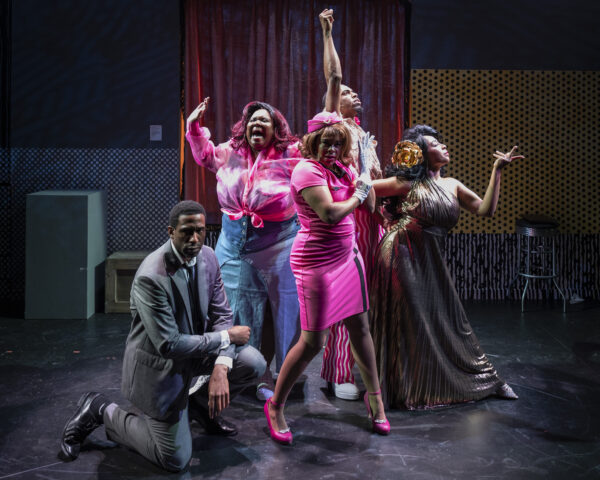 William Oliver Watkins, Kelli Blackwell, Ayanna Bria Bakari,
Matthew Elijah Webb, and Iris Beaumier
William Oliver Watkins, Kelli Blackwell, Ayanna Bria Bakari,
Matthew Elijah Webb, and Iris BeaumierThere are a few other skits that, like this one, are a bit confusing. But the play’s end ties together all the pieces with all five characters on stage having a large dance party.
In all, The Colored Museum feels like a successful attempt at experimental theater. It may not be a size-fits-all for all audience members, but the experience of witnessing this production will definitely give you food for thought you won’t forget any time soon.
Iris Beaumier and William Oliver Watkins
photos by Teresa Castracane
The Colored Museum
Studio Theatre
Victor Shargai Stage, 1501 14th Street NW in Washington, DC
ends on August 11, 2024
for tickets ($40-$114), visit Studio Theatre
